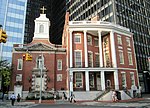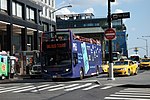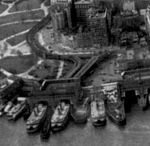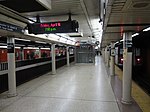17 State Street

17 State Street is a 42-story office building located in the Financial District of Manhattan, overlooking State Street and Battery Park. It was designed by Roy Gee for Emery Roth and Sons for developers William Kaufman Organization, and it is most noted for its distinct curved glass facade. The building has been owned by RFR Holding since 1999 when it was acquired from Savannah Teachers Properties Inc. for $120 million.17 State Street was affected by Hurricane Sandy in October 2012, primarily by water damage to electrical equipment in the building's basement. For that reason, the building was closed for repairs for approximately two weeks and was one of the earliest office buildings in the Financial District to be reoccupied after the storm.
Excerpt from the Wikipedia article 17 State Street (License: CC BY-SA 3.0, Authors, Images).17 State Street
State Street, New York Manhattan
Geographical coordinates (GPS) Address External links Nearby Places Show on map
Geographical coordinates (GPS)
| Latitude | Longitude |
|---|---|
| N 40.702795 ° | E -74.01412 ° |
Address
17 State Street
State Street
10275 New York, Manhattan
New York, United States
Open on Google Maps









